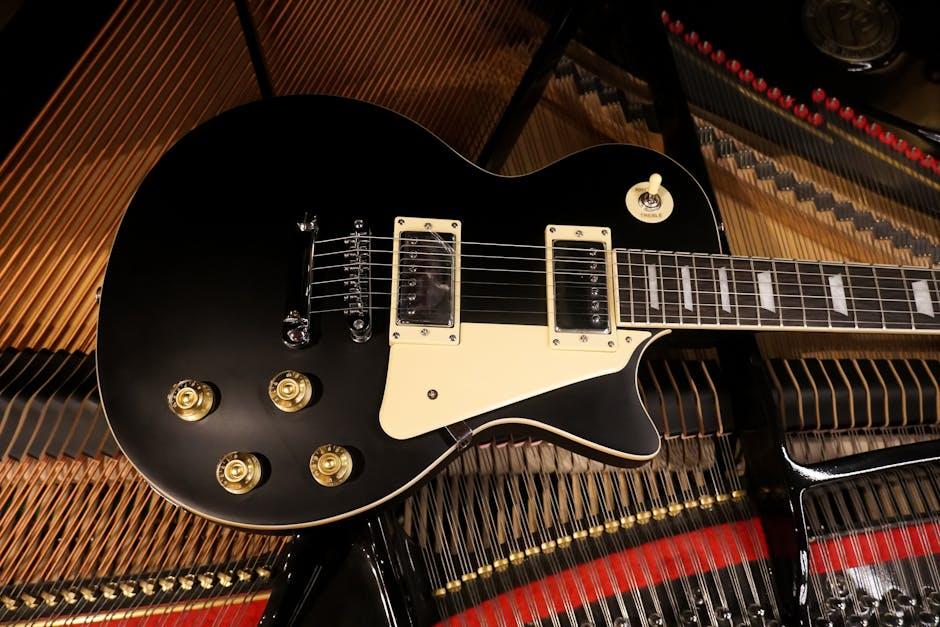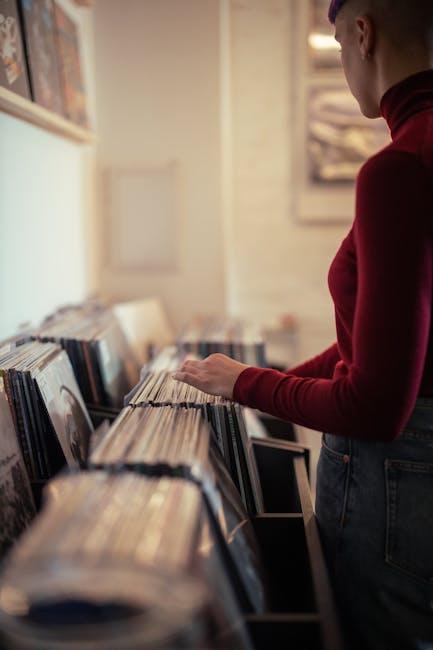In the ever-evolving landscape of music, sounds from the past have a way of resurfacing, captivating new generations while rekindling the passions of longtime listeners. Music genre revivals are a fascinating phenomenon where styles once considered vintage or outmoded experience a renaissance, blending nostalgia with contemporary innovation. From the soulful echoes of jazz to the pulsating rhythms of disco, these revivals remind us that musical history is cyclical, and that every era holds the seeds for creative rebirth. This article explores the dynamics behind music genre revivals, uncovering why and how certain sounds return to the forefront of cultural consciousness.
Table of Contents
- The Resurgence of Classic Rock in Modern Music Scenes
- Exploring the Revival of Synthpop and Its Cultural Impact
- How Jazz Fusion is Finding New Audiences Today
- The Role of Streaming Platforms in Genre Resurgences
- Practical Tips for Aspiring Musicians Embracing Revival Styles
- Balancing Nostalgia and Innovation in Genre Comebacks
- Q&A
- The Way Forward

The Resurgence of Classic Rock in Modern Music Scenes
In recent years, classic rock has experienced a remarkable revival, weaving its way back into the fabric of contemporary music culture. Modern artists are increasingly drawing inspiration from the gritty riffs, emotive vocals, and anthemic choruses that defined the genre decades ago. This blend of nostalgia and innovation has not only attracted long-time fans but has also introduced younger generations to the enduring power of classic rock. Vinyl sales, festivals dedicated to legendary bands, and the resurgence of analog recording techniques are just a few indicators of this renewed interest.
Several factors contribute to this resurgence, including:
- Collaborations between modern musicians and classic rock icons, bridging generational gaps.
- Streaming platforms curating playlists that highlight timeless tracks alongside modern reinterpretations.
- Fashion and pop culture embracing retro aesthetics closely tied with classic rock’s iconic imagery.
| Element | Modern Adaptation | Classic Influence |
|---|---|---|
| Guitar Tone | Digital pedalboards | Distorted analog amps |
| Vocals | Layered harmonies | Powerful lead vocals |
| Songwriting | Eclectic genre blending | Story-driven lyrics |

Exploring the Revival of Synthpop and Its Cultural Impact
The resurgence of synthpop is more than a mere nod to the 1980s; it’s a dynamic reimagining that fuses nostalgia with modern innovation, breathing new life into an iconic sound. Artists are layering lush synthesizers with contemporary production techniques, crafting melodies that are both familiar and futuristic. This revival taps into a collective desire for escapism and emotional clarity, resonating deeply with audiences across generations. Synthpop’s melodic hooks and hypnotic rhythms offer a sonic sanctuary in an era dominated by digital noise, rekindling a dialogue between past and present musical landscapes.
Beyond the auditory sphere, the cultural ripple effect is equally compelling. Fashion, visual arts, and even film are drawing inspiration from the synth-driven aesthetic, characterized by neon hues, geometric shapes, and a sleek, cyber-infused vibe. Communities online celebrate synthpop’s ethos with a blend of fandom and creativity, often through remix culture, fan art, and themed events. The genre’s revival highlights key cultural themes:
- Technological nostalgia: Embracing vintage synth hardware and analog warmth.
- Emotional transparency: Lyrics often explore vulnerability and modern existentialism.
- Intergenerational appeal: Bridging the gap between original fans and new listeners.
| Element | Classic Synthpop | Modern Revival |
|---|---|---|
| Instrumentation | Analog synths, drum machines | Hybrid synths, digital layering |
| Production Style | Raw, lo-fi textures | Polished, high-definition soundscapes |
| Themes | Romanticism, futurism | Introspection, digital life |

How Jazz Fusion is Finding New Audiences Today
Jazz fusion, once a niche genre blending the complexity of jazz with the electric energy of rock, is experiencing a fresh surge in popularity. This revival is fueled by a new generation of musicians who are reinterpreting the style with contemporary production techniques and diverse cultural influences. Social media platforms, especially streaming services and music-sharing apps, have become crucial in exposing jazz fusion to audiences who might not have encountered it otherwise. These platforms allow artists to showcase their innovative takes, weaving traditional jazzy melodies with electronic beats and modern rhythms. Crowdsourced playlists and algorithmic recommendations also play a significant role in introducing jazz fusion tracks to eclectic listeners around the globe.
Moreover, the integration of jazz fusion into other popular music forms has expanded its reach. Here are some key drivers redefining the genre’s appeal today:
- Collaborations between jazz fusion artists and hip-hop performers, merging improvised solos with rap verses.
- Festival lineups featuring cross-genre acts, where jazz fusion shares stages with indie and electronic artists.
- Educational programs and podcasts that demystify the genre’s complex structures, making it more accessible.
| Platform | Unique Feature | Impact |
|---|---|---|
| Spotify | Fusion-focused playlists | Broadened listenership |
| Bandcamp | Direct artist support | Empowered indie fusion acts |
| SoundCloud | Spontaneous track sharing | Early exposure for new talent |

The Role of Streaming Platforms in Genre Resurgences
Streaming platforms have transformed the way listeners discover and engage with music, acting as powerful catalysts for the resurgence of forgotten or niche genres. By curating personalized playlists and introducing advanced recommendation algorithms, these platforms create a bridge between past and present sounds. Genres that once lived on the fringes find new audiences eager to explore their unique rhythms and stories. This democratization of access helps obscure or overlooked music styles reemerge, rejuvenating entire scenes and inspiring contemporary artists to incorporate vintage influences into modern compositions.
Moreover, streaming services encourage community-building through features like collaborative playlists and social sharing, which amplify the visibility of resurgent genres. Fans and newcomers alike can participate in the evolution of these styles, often leading to hybrid subgenres and exciting musical experiments. Some key factors contributing to their influence include:
- Algorithmic Discoveries: Custom-tailored suggestions expose users to adjacent genres they might have missed.
- Global Access: World music and regional genres find international recognition far beyond traditional boundaries.
- Revival Campaigns: Curated playlists dedicated to genres rediscover classic tracks and spotlight emerging artists.
| Genre | Streaming Growth (%) | Notable Playlist |
|---|---|---|
| Synthwave | 320 | Neon Retro Vibes |
| Disco | 210 | Saturday Night Boogie |
| Lo-fi Hip Hop | 280 | Chill Beats to Study To |
| Afrobeat | 350 | Global Afro Rhythms |

Practical Tips for Aspiring Musicians Embracing Revival Styles
Embracing a revival style as a musician means diving deep into the roots while adding your own modern twist. Start by immersing yourself in the history and culture behind the genre. This involves not only listening to classic records but also understanding the social and musical context that shaped its sound. Experiment with authentic instruments and traditional recording techniques to capture the vintage essence, but don’t hesitate to fuse contemporary elements that resonate with today’s audiences. Consistent practice and critical listening are key—try recreating iconic songs then gradually incorporate your personal flair.
Collaborate with other musicians who share your passion for revival styles to expand your creative horizons. Network within communities dedicated to that genre, both online and offline. Here are some practical steps to keep in mind:
- Study influential artists closely and analyze what made their sound timeless.
- Attend live performances or watch recorded concerts to observe stage presence and audience engagement.
- Utilize period-specific gear when possible to ensure authenticity.
- Maintain a journal of musical ideas inspired by your research and experimentation.
| Tip | Why It Matters |
|---|---|
| Learn the history | Deepens connection and authenticity |
| Use vintage gear | Preserves the sound’s original character |
| Network actively | Builds supportive creative communities |
| Experiment freely | Keeps tradition fresh and relevant |

Balancing Nostalgia and Innovation in Genre Comebacks
Striking the perfect chord between nostalgia and innovation is a delicate dance for artists exploring genre revivals. While fans are drawn to the familiar sounds that evoke memories, today’s listeners also crave fresh elements that push boundaries and reflect contemporary sensibilities. This balancing act often involves revisiting classic production techniques or iconic rhythms while daring to blend them with modern electronic textures, unexpected instruments, or cross-genre collaborations. The challenge lies in respecting the roots without succumbing to mere replication, creating a space where the past is honored but not trapped in a time capsule.
Successful genre comebacks frequently share some key strategies that enable them to resonate across generations:
- Selective Reinvention: Incorporating signature motifs alongside innovative twists keeps listeners engaged without alienating purists.
- Storytelling Through Sound: Using lyrics and production choices to reflect current social themes revitalizes classic genres with new purpose.
- Community Invitation: Encouraging fan interaction and remixes builds shared ownership and breathes ongoing life into revived genres.
| Classic Element | Modern Innovation | Resulting Effect |
|---|---|---|
| Vinyl crackle & warm analog sound | Layered synth pads and digital effects | Rich texture blending old-school vibe with futuristic tones |
| Retro drum machine beats | Polyrhythmic patterns & live percussion | Energetic grooves that feel both nostalgic and dynamic |
| Call-and-response vocals | Processing and vocal harmonizers | Dynamic conversations between raw emotion and polished production |
Q&A
Q: What exactly is a music genre revival?
A: A music genre revival occurs when a particular style of music, often one that has faded from mainstream popularity, experiences a renewed interest and resurgence. This can happen through new artists adopting the genre’s signature sound, nostalgic cultural movements, or fresh reinterpretations that resonate with modern audiences.
Q: Why do music genre revivals happen?
A: Revivals often arise from a combination of nostalgia, cyclical cultural trends, and the search for authenticity or fresh inspiration in music. Listeners and artists alike revisit past genres to rediscover their unique qualities, reinterpret them, or simply find comfort in familiar sounds during changing times.
Q: Can you give examples of notable music genre revivals?
A: Absolutely. The swing revival of the late 1990s, with bands like The Brian Setzer Orchestra, brought big band jazz back into the spotlight. More recently, the resurgence of synthwave echoed the iconic 1980s electronic sounds in a modern context. Even genres like folk and disco have seen waves of renewed interest.
Q: How do modern artists approach genre revivals?
A: Contemporary musicians often blend traditional elements of a genre with modern production techniques and sensibilities. This hybrid approach can make older music styles feel fresh and relevant, bridging generational gaps while honoring the genre’s roots.
Q: Are music genre revivals purely commercial, or do they have cultural significance?
A: While commercial factors play a role, revivals often carry deep cultural and artistic significance. They reflect society’s evolving relationship with music history, identity, and collective memory. By reviving a genre, artists and fans can reconnect with cultural heritage, challenge current trends, or inspire innovation.
Q: Do all music genre revivals lead to long-lasting changes in the industry?
A: Not always. Some revivals are brief and largely nostalgic, sparking temporary bursts of popularity. Others can profoundly influence the industry, spawning subgenres or reshaping mainstream sounds. The longevity largely depends on how well the revival resonates beyond fleeting trends.
Q: How do listeners typically respond to genre revivals?
A: Responses vary widely. Longtime fans often celebrate the return of beloved sounds, while new listeners might find the revived genre novel and exciting. For some, revivals spark rediscovery and deeper exploration of a genre’s history, enriching their musical appreciation.
Q: What role do technology and social media play in genre revivals?
A: Technology and social media accelerate revivals by allowing rare or forgotten music to reach wider audiences quickly. Streaming platforms curate vintage sounds alongside contemporary hits, while social media trends can popularize retro aesthetics and sounds almost overnight, fueling new waves of enthusiasm.
Q: Can a genre revival inspire new creative movements?
A: Yes. Revivals often act as catalysts for innovation, inspiring artists to experiment and develop new styles that blend the past with the present. This creative fusion can lead to entirely new genres or movements, perpetuating the evolving nature of music.
Q: What might the future hold for music genre revivals?
A: As global access to music history grows and artists continue exploring diverse influences, genre revivals are likely to remain a vibrant force. Future revivals may surprise us by unearthing obscure sounds or fusing disparate styles in unexpected ways, reflecting the ever-changing landscape of musical creativity.
The Way Forward
As melodies from the past find new life in today’s soundscape, music genre revivals remind us that the beat of history is never truly silent. Whether it’s the soulful echoes of jazz, the rebellious roar of punk, or the shimmering synths of ’80s pop, these resurgences invite both old fans and new listeners to rediscover the magic that once shaped culture and continues to inspire creativity. In the end, music’s perpetual cycle of revival is not just a nod to nostalgia—it’s a testament to the timeless power of sound to evolve, connect, and endure.

